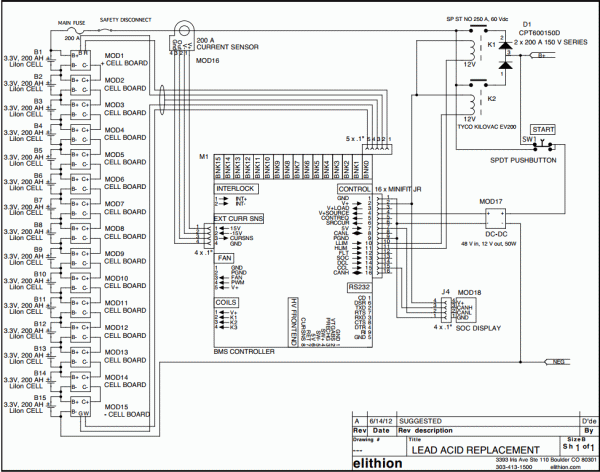
More and more people wish to replace their lead acid batteries with Li-ion batteries.
Batteries that consists of just Li-ion cells are not a direct, drop in replacement for lead acid batteries.
That is because they are somewhat different:
| Lead acid batteries
| Li-ion cells
|
| Managed by monitoring the battery pack voltage
| Managed by monitoring each individual cell voltage
|
| Survives being discharged down to 0 V
| Damaged if discharged below about 2 V / cell
|
| May be trickle charged
| Damaged if charged past 3.6 (or 4.2 V) / cell
|
| Benign if abused
| Risk of fire if abused
|
| Do not require a protection switch
| Require two protection switches: one for charging, one for discharging
|
| May be used at all temperatures
| Cannot be charged below 0°C, have a more limited temperature range
|
In addition to the Li-ion cells, a Li-ion battery used to replace a Lead Acid battery requires:
- A Battery Management System (BMS)
- A way for the BMS to stop charging when ANY cell is unable to accept any more current
- A way for the BMS to stop discharging when ANY cell is unable to deliver any more current
The problems with some systems that were originally designed for Lead Acid are that:
- They have no provision to control and stop charging current
- They have no provision to control and stop discharging current
- They use the same path for charging and discharging
Two separate paths are required because there are times when the battery is able to discharge, but not charge:
- Because a cell is full
- Because it's warm enough for discharging, but too cold for charging
Also, there are times when the battery is able to charge, but not discharge:
- Because a cell is empty
- Because the output is overloaded
The ideal solution is to change the system so that it does separate the charging and discharging path, and that each path may be controlled by the BMS.
However, we understand that that is not likely to happen.
Therefore, please let us offer a solution in the form of this proposed circuit:

Suggested circuit for a Lead Acid replacement Li-ion battery.
Click for full size
pdf version
This example is for a 48 V battery, but the basic princible is applicable to other voltages as well.
Principles of operation:
- Two rectifier diodes are used to steer the charging and discharging current into two separate paths
- Each path has its own relay (contactor)
- The BMS controls each contactor independently, so that it may enable just charging, just discharging, both or neither (as required)
- The BMS is powered by a DC-DC converter
- The DC-DC converter is not powered directly by the Li-ion cells, because otherwise it would be able to over-discharge the cells even after the BMS decided that they could no longer deliver any current
- Instead, the DC-DC converter is powered by the battery output terminals (after the discharge contactor)
- Should the BMS shut off discharge, it will also shut off the DC-DC converter, and therefore shut itself down
- When power comes back, voltage appears across the battery ouput terminals, powers the DC-DC converter, which powers the BMS, which turn on the charge contactor, allowing the recharging of the battery

